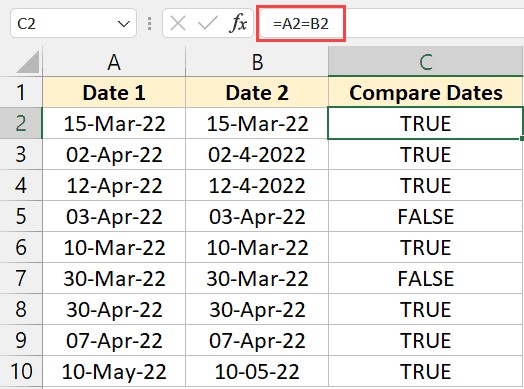Comparing dates in Excel can be tricky due to various formatting options. While two dates might appear identical, their underlying values could differ. This tutorial provides effective techniques to compare dates in Excel, determining if they are the same or if one is greater/less than the other.
Understanding Excel’s Date Storage
Before diving into comparison methods, it’s crucial to understand how Excel stores dates and times. Excel represents dates as whole numbers, starting from January 1, 1900, as day 1. For instance, 1 represents January 1, 1900, and 44927 represents January 1, 2023.
Time values are stored as decimal fractions. 0.5 represents 12:00 PM (noon), while 0.25 represents 6:00 AM. A combined date and time value, like 44927.5, represents January 1, 2023, at 12:00 PM.
This numerical representation allows Excel to perform calculations with dates and times. However, it’s important to note that invalid date formats, such as “Jan 01, 2023,” will be treated as text strings.
Direct Comparison Using the Equal-To Operator
The simplest method to compare two dates is using the equal-to operator (=). For example, =A2=B2 compares the dates in cells A2 and B2. This formula returns TRUE if the dates are identical and FALSE if they are different.
Important Considerations:
- Formatting Differences: Dates with different formats but the same underlying numerical value will be considered equal.
- Hidden Time Values: Dates might appear the same but have different time components, leading to a FALSE result. Row 5 and 7 in the image above illustrate this scenario.
- Text Strings: Dates entered as text cannot be compared using this method. Ensure your dates are in a valid Excel date format.
Comparing Dates with the IF Function
The IF function provides more nuanced comparisons, allowing you to check for greater than, less than, or equal to conditions. For instance, =IF(C2<=B2,"In Time","Delayed") checks if the date in C2 is less than or equal to the date in B2. It returns “In Time” if true and “Delayed” if false.
You can create more complex comparisons by nesting IF statements. This formula checks if a report submission is “In Time,” within a 5-day “Grace” period, or “Delayed”:
=IF(C2-B2<=0,"In Time",IF(C2-B2<=5,"Grace","Delayed"))
This formula utilizes date subtraction, which is possible due to Excel’s numerical date representation. Subtracting dates yields the number of days between them.
Comparing Dates with Time Values
When comparing dates that include time values, hidden time components can lead to unexpected results. The INT function helps address this issue by extracting only the integer part of the date, effectively ignoring the time.
For example, =INT(A2)=INT(B2) compares only the date portions of A2 and B2, disregarding any time differences. This ensures accurate comparison even when cells are formatted to hide time values.
Summary of Comparison Operators
Here’s a list of operators you can use for date comparisons in Excel:
- Equal to (=)
- Greater Than (>)
- Less Than (<)
- Greater Than or Equal to (>=)
- Less Than or Equal to (<=)
- Not Equal to (<>)
By understanding Excel’s date storage system and utilizing the techniques outlined in this tutorial, you can effectively compare dates and achieve accurate results in your spreadsheets. Whether it’s a simple equality check or a more complex conditional comparison, Excel provides the tools to manage your date data efficiently.
